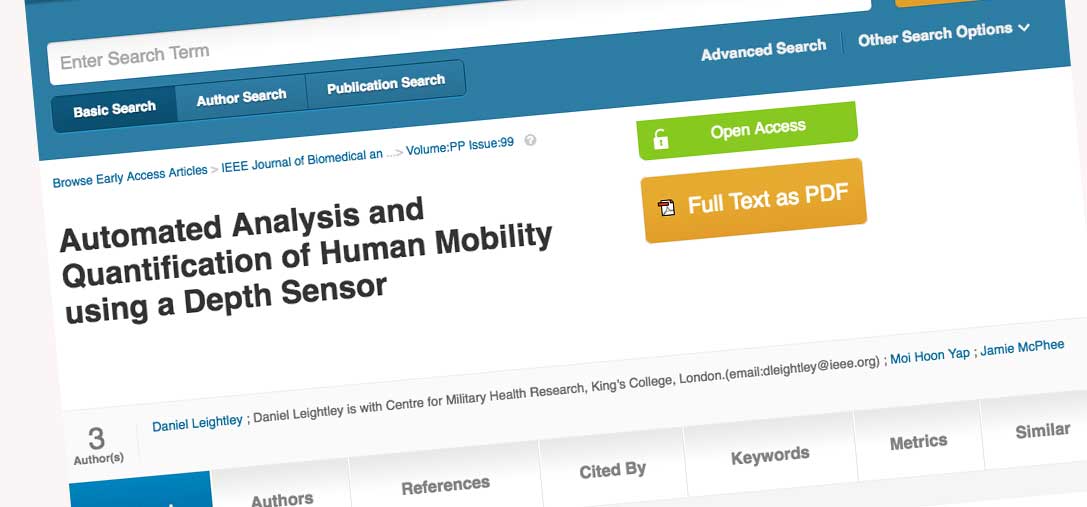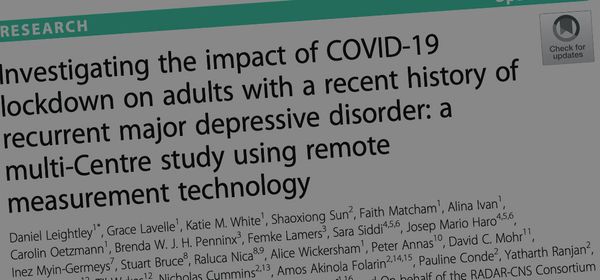Journal of Biomedical and Health Informatics - Paper Accepted and Published
Great news, my first ever journal paper has been accepted to appear in the Journal of Biomedical and Health Informatics (J-BHI). I am over the moon and very pleased. The paper is the culmination of my PhD, bringing together motion capture, 3D feature representation, big data, little data and machine learning. J-BHI was choosen for submission as its aims and objectives fitted well with our work.
The paper focuses on quantification of human motion to support clinicians in the decision-making process. We proposed a framework that automatically recognises and evaluates human mobility impairments using a depth sensor. The framework is composed of two parts. Firstly, it recognises motions, such as sit-to-stand or walking 4 metres, using feature representation techniques and machine learning. Secondly, evaluation of the motion sequence in the temporal domain by comparing the test participant with a statistical mobility model, generated from tracking movements of healthy people. Finally, we demonstrated the ability of the framework to recognise and provide clinically relevant feedback to highlight mobility concerns, hence providing a route towards stratified rehabilitation pathways and clinician led interventions.
Length of time in review
I submitted the manuscript via ScholarOne Manuscript Central on the 22nd November 2015, on the 16th January 2016 I received the first notification - Reject/Re-submission with Major Revisions. The main criticism of the work; language used was "flowery", repetitive and too long. Each point constructive and valid, I was overall very happy with the feedback as it sought to improve the quality of the manuscript. I set about making drastic changes and re-submitted on the 14th March 2016 and final notification was received on the 19th April 2016 - accepted! From first submission to final acceptance was 149 days (4 months 28 days). If I remove the time taken to revise the manuscript it was actually 91 days (2 months 29 days). Which is fantastic compared to most Computer Science journals.
Status definitions
Through each stage of the manuscript review process I resorted to Google to understand what each status meant (J-BHI don't provide these on the website). For me it is impossible to just submit, wait and not look at the status of the manuscript. I have seen the following status categories used and my interpretation of their meanings are:
- Awaiting AE Assignment: Manuscript is awaiting an Associate Editor (AE) to be assigned. It is my understanding that they are approached by the Journal and invited to be the AE for the manuscript, however they can decline the invitation.
- Awaiting Reviewer Selection: Once the AE has been selected he/she sends out reviewer invitations. Typically they send it to approximately 4 or 5 reviewers. These reviewers may be selected based on your recommendation and those believed to be suitable by the AE.
- Awaiting Reviewer Feedback: Reviewers have accepted the invitation and are currently reviewing the manuscript. This can be the longest part of the whole process. It is normal for this to take months, sometimes reviewers may never respond with comments or they request an extension. After one month I would recommend politely getting in touch with the AE to ask for a status update.
- Awaiting AE Decision: After the AE has collated all the reviewer feedback they are required to make a decision. This is usually; a) accept with no changes b) accept with minor changes c) accept with major changes or d) reject. When this status appears you usually get a decision very quickly. If you are waiting more than two weeks I'd get in touch with the AE.
Conclusions
I now intend to submit another paper to J-BHI and hope we get the same experience. Overall the process of submitting to a Journal was stressful, mainly because I didn't really understand the work required to generate a manuscript, prepare and submit.
I welcome any comments anyone may have on this blog post, or the manuscript itself.



